Abstract
1. Our aim was to determine if sympathetic vasodilatation occurs in the human forearm, and if the vasodilating substance nitric oxide contributes to this dilatation. We also sought to determine if the nitric oxide might be released as a result of cholinergic stimulation of the vascular endothelium. 2. Blood flow was measured in the resting non-dominant forearm with venous occlusion plethysmography. To increase sympathetic traffic to the resting forearm, rhythmic handgrip exercise to fatigue followed by post-exercise ischaemia was performed by the dominant forearm. A brachial artery catheter in the non-dominant arm was used to selectively infuse drugs. 3. During control conditions, there was mild vasodilatation in the resting forearm during exercise followed by constriction during post-exercise ischaemia. When exercise was performed after brachial artery administration of bretylium (to block noradrenaline release) and phentolamine (an alpha-adrenergic antagonist), profound vasodilatation was seen in the resting forearm during both exercise and post-exercise ischaemia. 4. When the nitric oxide synthase blocker NG-monomethyl-L-arginine (L-NMMA) was administered in the presence of bretylium and phentolamine prior to another bout of handgripping, little or no vasodilatation was seen either during exercise or post-exercise ischaemia. Atropine also blunted the vasodilator responses to exercise and post-exercise ischaemia after bretylium and phentolamine. 5. These results support the existence of active sympathetic vasodilatation in the human forearm and the involvement of nitric oxide in this phenomenon. They also suggest nitric oxide might be released as a result of cholinergic stimulation of the vascular endothelium.
Full text
PDF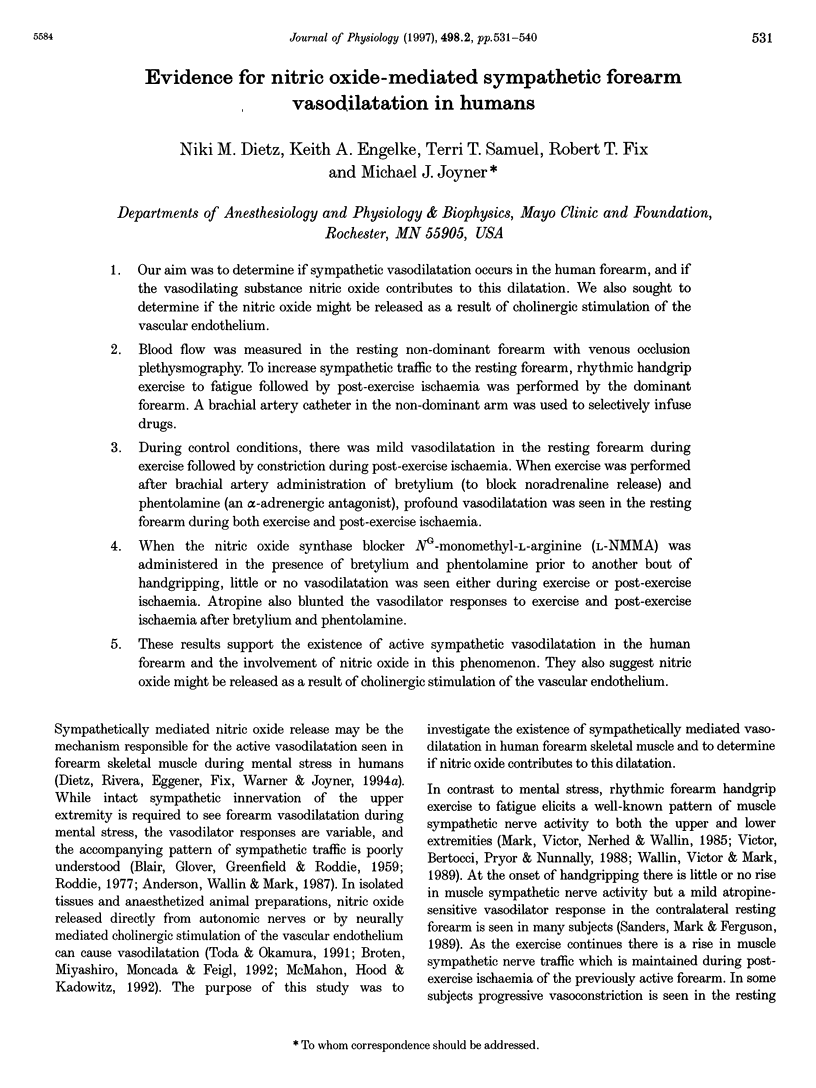
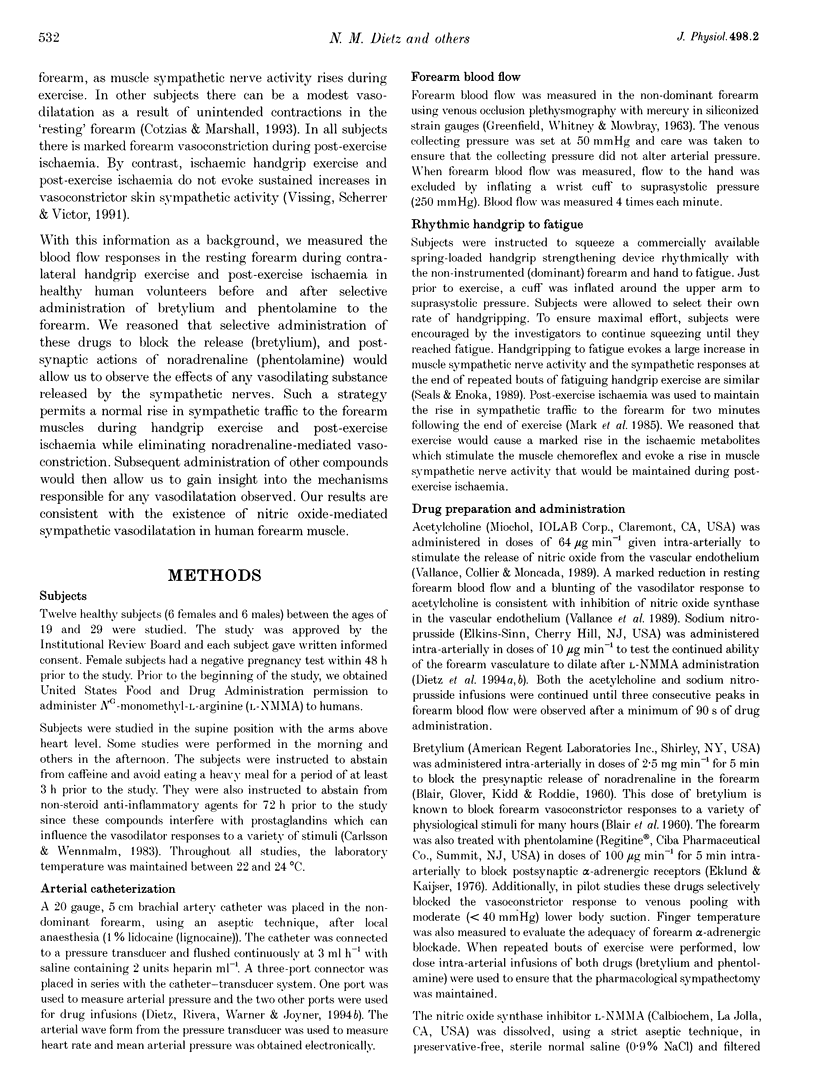
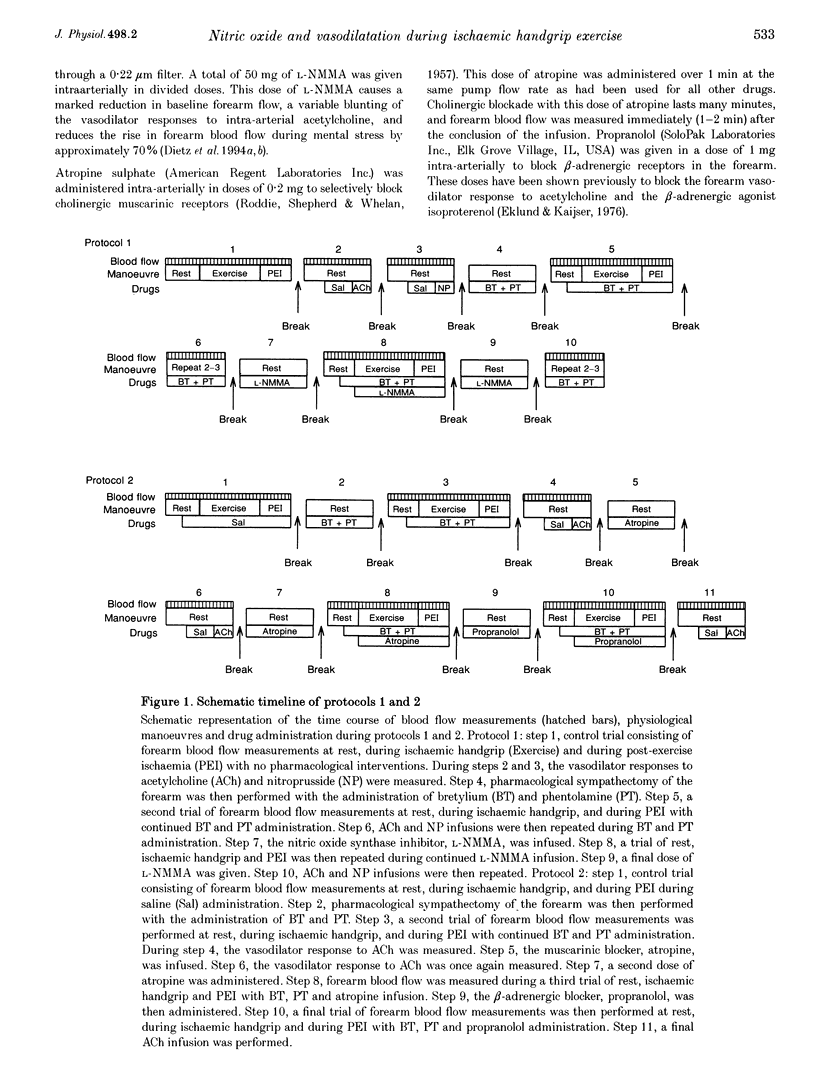
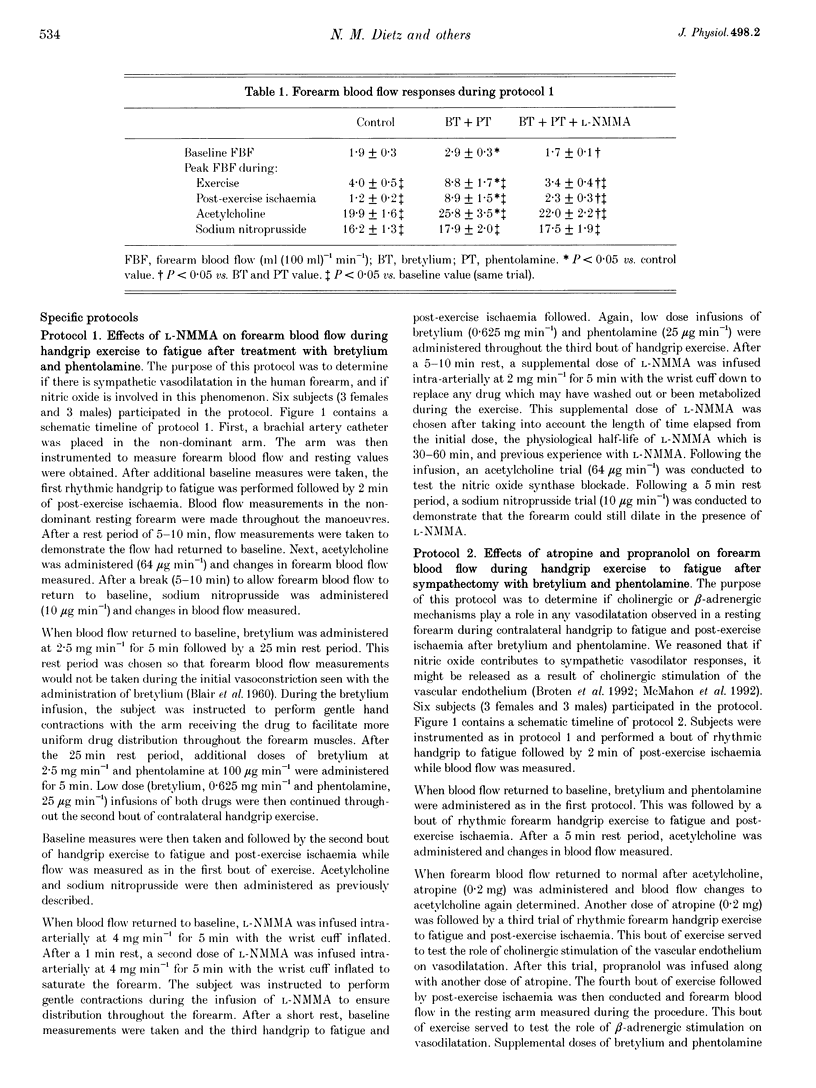
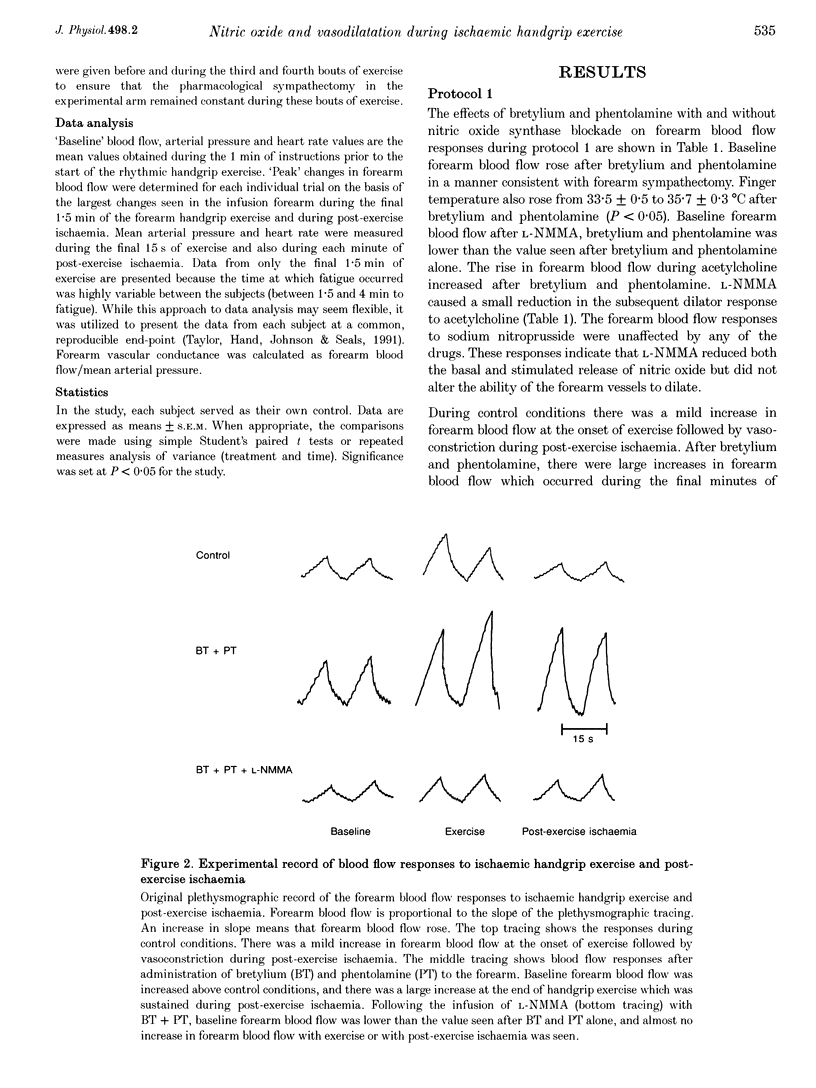
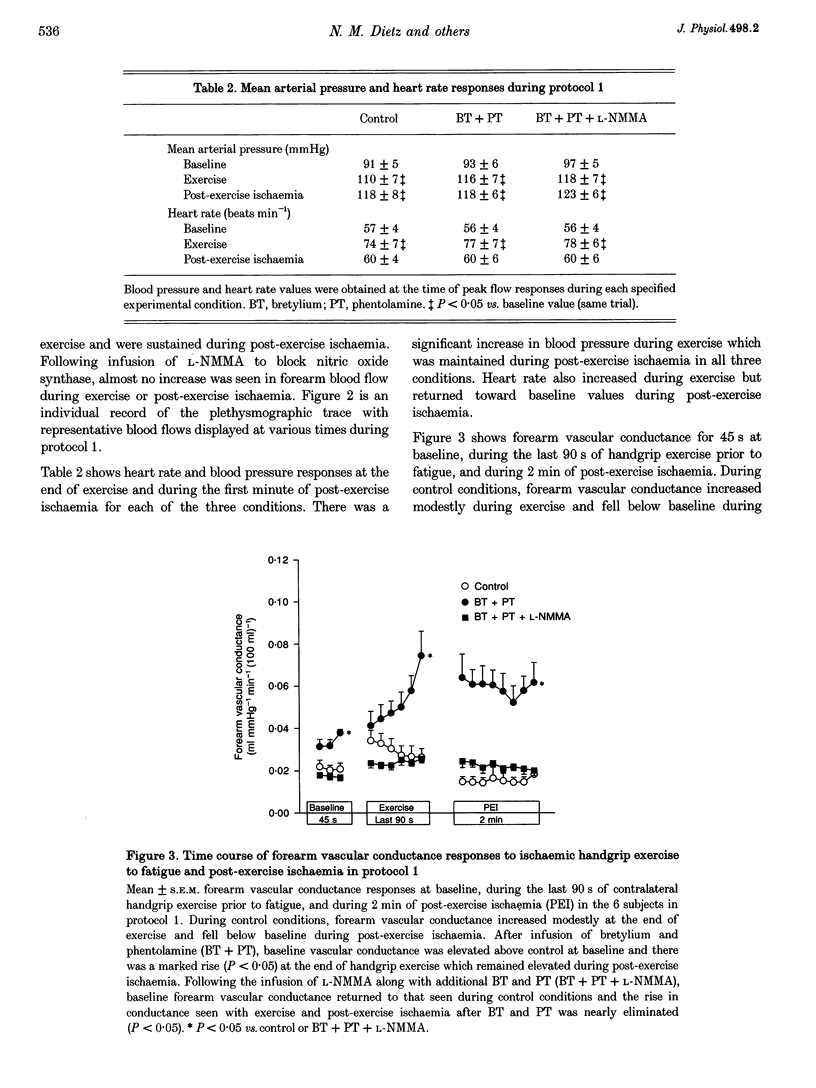
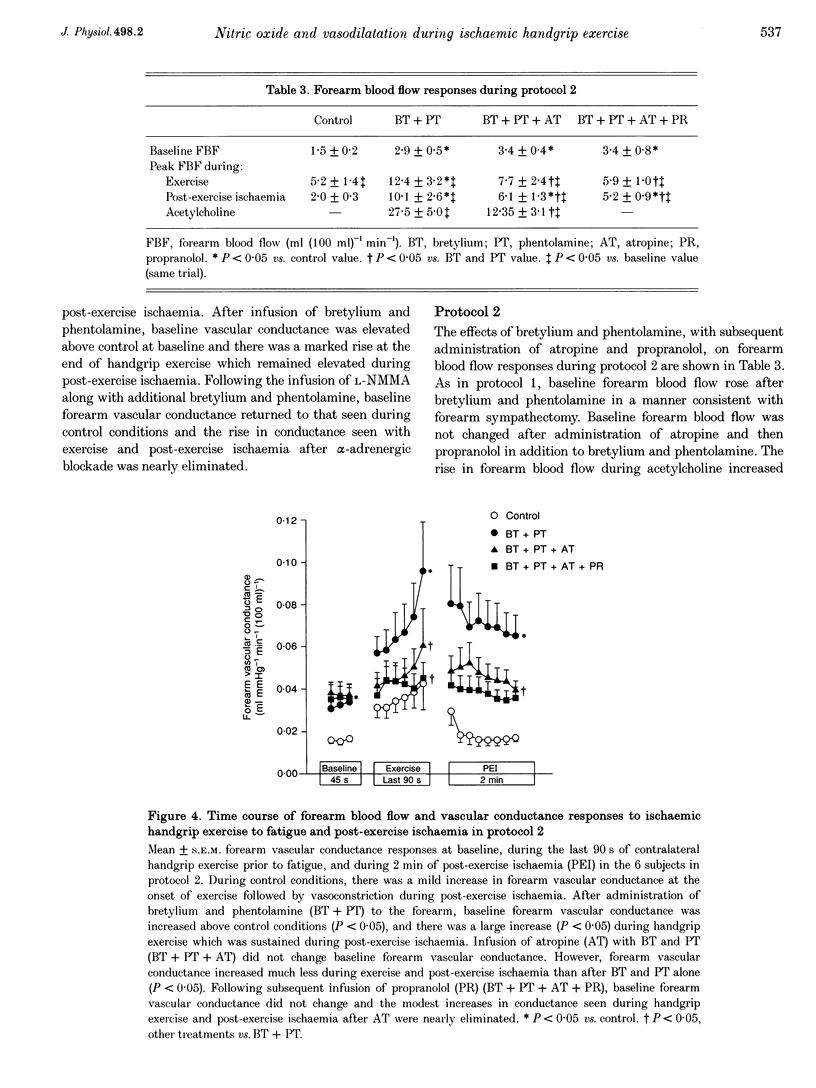
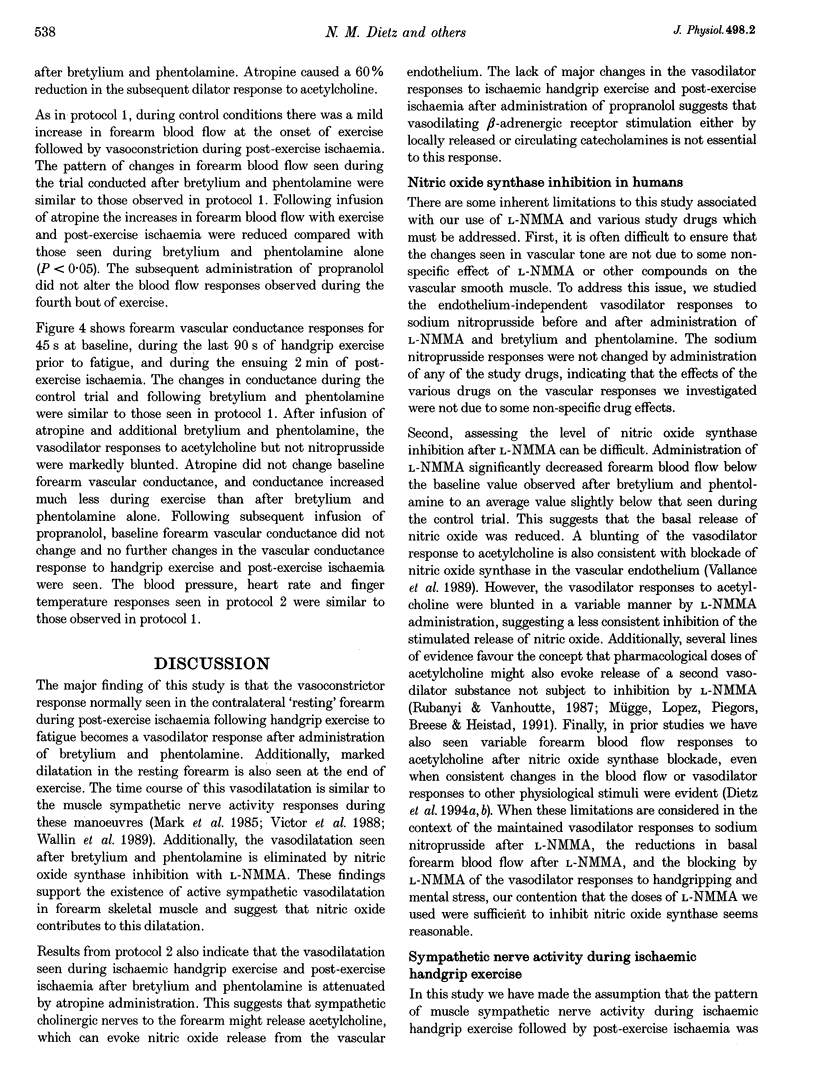
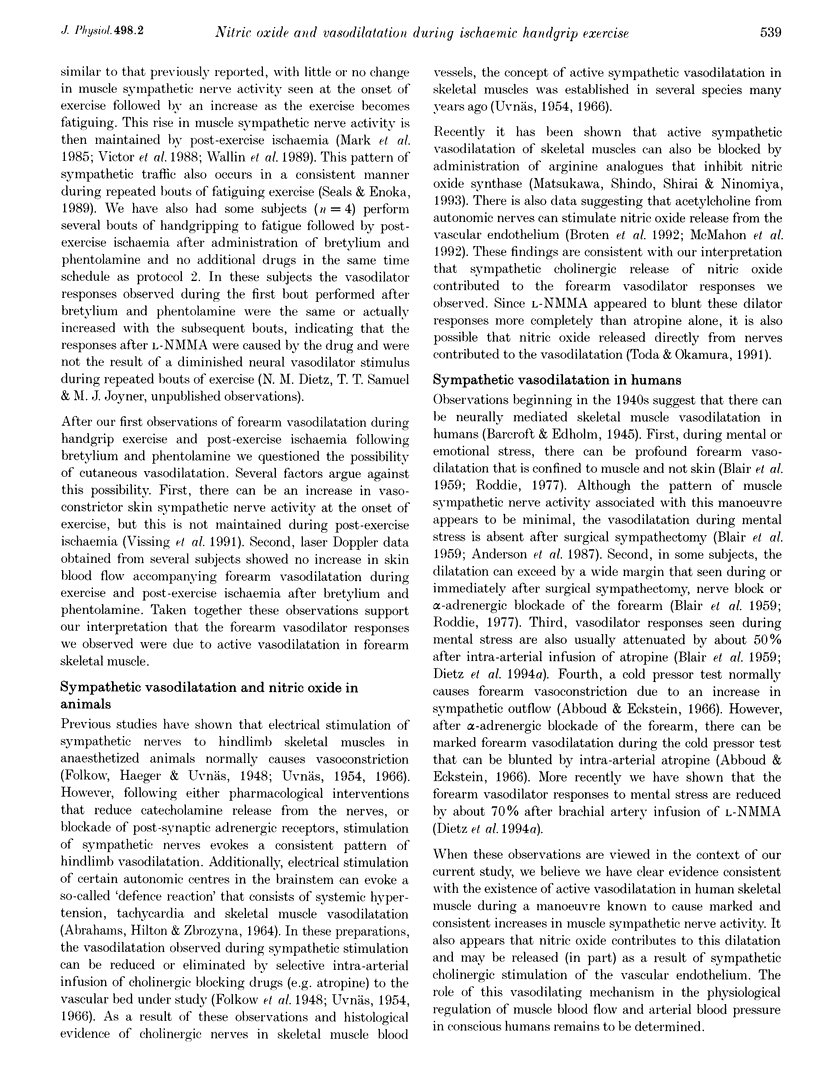
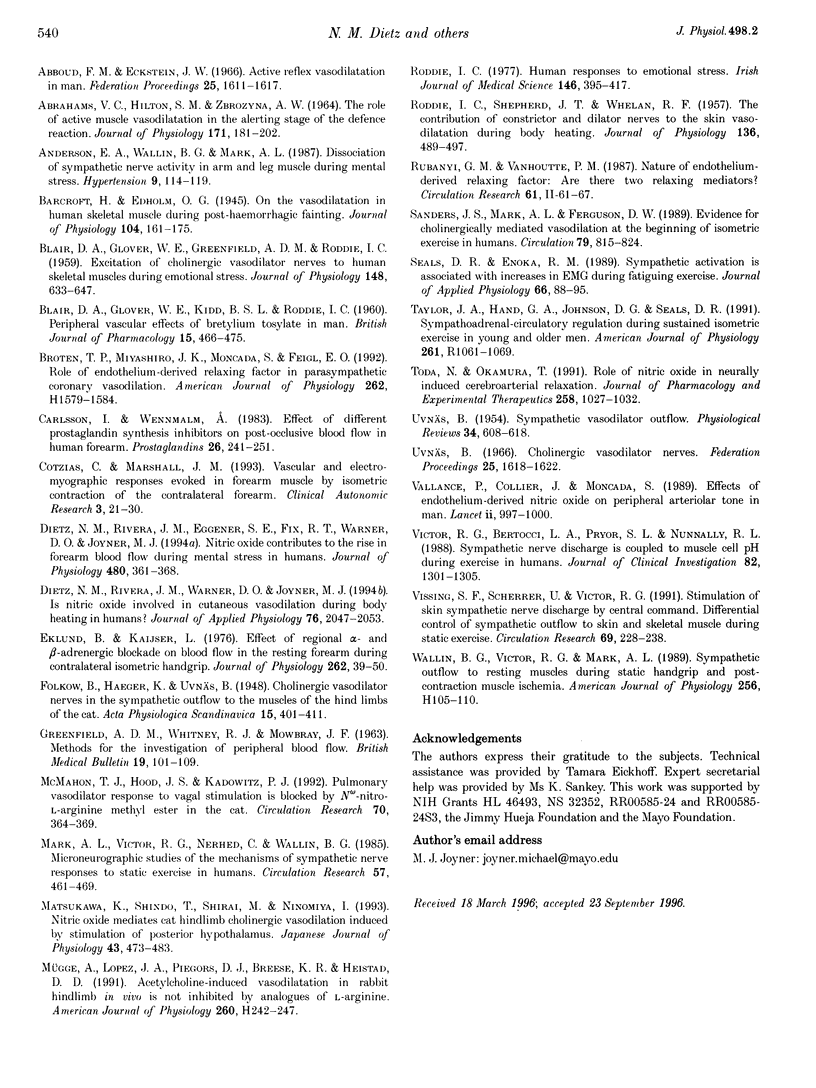
Selected References
These references are in PubMed. This may not be the complete list of references from this article.
- ABRAHAMS V. C., HILTON S. M. THE ROLE OF ACTIVE MUSCLE VASODILATATION IN THE ALERTING STAGE OF THE DEFENCE REACTION. J Physiol. 1964 Jun;171:189–202. doi: 10.1113/jphysiol.1964.sp007371. [DOI] [PMC free article] [PubMed] [Google Scholar]
- Abboud F. M., Eckstein J. W. Active reflex vasodilatation in man. Fed Proc. 1966 Nov-Dec;25(6):1611–1617. [PubMed] [Google Scholar]
- BLAIR D. A., GLOVER W. E., GREENFIELD A. D., RODDIE I. C. Excitation of cholinergic vasodilator nerves to human skeletal muscles during emotional stress. J Physiol. 1959 Oct;148:633–647. doi: 10.1113/jphysiol.1959.sp006312. [DOI] [PMC free article] [PubMed] [Google Scholar]
- Barcroft H., Edholm O. G. On the vasodilatation in human skeletal muscle during post-haemorrhagic fainting. J Physiol. 1945 Oct 15;104(2):161–175. doi: 10.1113/jphysiol.1945.sp004113. [DOI] [PMC free article] [PubMed] [Google Scholar]
- Broten T. P., Miyashiro J. K., Moncada S., Feigl E. O. Role of endothelium-derived relaxing factor in parasympathetic coronary vasodilation. Am J Physiol. 1992 May;262(5 Pt 2):H1579–H1584. doi: 10.1152/ajpheart.1992.262.5.H1579. [DOI] [PubMed] [Google Scholar]
- Carlsson I., Wennmalm A. Effect of different prostaglandin synthesis inhibitors on post-occlusive blood flow in human forearm. Prostaglandins. 1983 Aug;26(2):241–252. doi: 10.1016/0090-6980(83)90092-8. [DOI] [PubMed] [Google Scholar]
- Cotzias C., Marshall J. M. Vascular and electromyographic responses evoked in forearm muscle by isometric contraction of the contralateral forearm. Clin Auton Res. 1993 Feb;3(1):21–30. doi: 10.1007/BF01819139. [DOI] [PubMed] [Google Scholar]
- Dietz N. M., Rivera J. M., Eggener S. E., Fix R. T., Warner D. O., Joyner M. J. Nitric oxide contributes to the rise in forearm blood flow during mental stress in humans. J Physiol. 1994 Oct 15;480(Pt 2):361–368. doi: 10.1113/jphysiol.1994.sp020366. [DOI] [PMC free article] [PubMed] [Google Scholar]
- Dietz N. M., Rivera J. M., Warner D. O., Joyner M. J. Is nitric oxide involved in cutaneous vasodilation during body heating in humans? J Appl Physiol (1985) 1994 May;76(5):2047–2053. doi: 10.1152/jappl.1994.76.5.2047. [DOI] [PubMed] [Google Scholar]
- Eklund B., Kaijser L. Effect of regional alpha- and beta-adrenergic blockade on blood flow in the resting forearm during contralateral isometric handgrip. J Physiol. 1976 Oct;262(1):39–50. doi: 10.1113/jphysiol.1976.sp011584. [DOI] [PMC free article] [PubMed] [Google Scholar]
- GREENFIELD A. D., WHITNEY R. J., MOWBRAY J. F. Methods for the investigation of peripheral blood flow. Br Med Bull. 1963 May;19:101–109. doi: 10.1093/oxfordjournals.bmb.a070026. [DOI] [PubMed] [Google Scholar]
- Mark A. L., Victor R. G., Nerhed C., Wallin B. G. Microneurographic studies of the mechanisms of sympathetic nerve responses to static exercise in humans. Circ Res. 1985 Sep;57(3):461–469. doi: 10.1161/01.res.57.3.461. [DOI] [PubMed] [Google Scholar]
- Matsukawa K., Shindo T., Shirai M., Ninomiya I. Nitric oxide mediates cat hindlimb cholinergic vasodilation induced by stimulation of posterior hypothalamus. Jpn J Physiol. 1993;43(4):473–483. doi: 10.2170/jjphysiol.43.473. [DOI] [PubMed] [Google Scholar]
- McMahon T. J., Hood J. S., Kadowitz P. J. Pulmonary vasodilator response to vagal stimulation is blocked by N omega-nitro-L-arginine methyl ester in the cat. Circ Res. 1992 Feb;70(2):364–369. doi: 10.1161/01.res.70.2.364. [DOI] [PubMed] [Google Scholar]
- Mügge A., Lopez J. A., Piegors D. J., Breese K. R., Heistad D. D. Acetylcholine-induced vasodilatation in rabbit hindlimb in vivo is not inhibited by analogues of L-arginine. Am J Physiol. 1991 Jan;260(1 Pt 2):H242–H247. doi: 10.1152/ajpheart.1991.260.1.H242. [DOI] [PubMed] [Google Scholar]
- RODDIE I. C., SHEPHERD J. T., WHELAN R. F. The contribution of constrictor and dilator nerves to the skin vasodilatation during body heating. J Physiol. 1957 May 23;136(3):489–497. doi: 10.1113/jphysiol.1957.sp005775. [DOI] [PMC free article] [PubMed] [Google Scholar]
- Roddie I. C. Human responses to emotional stress. Ir J Med Sci. 1977 Dec;146(12):395–417. doi: 10.1007/BF03030998. [DOI] [PubMed] [Google Scholar]
- Sanders J. S., Mark A. L., Ferguson D. W. Evidence for cholinergically mediated vasodilation at the beginning of isometric exercise in humans. Circulation. 1989 Apr;79(4):815–824. doi: 10.1161/01.cir.79.4.815. [DOI] [PubMed] [Google Scholar]
- Seals D. R., Enoka R. M. Sympathetic activation is associated with increases in EMG during fatiguing exercise. J Appl Physiol (1985) 1989 Jan;66(1):88–95. doi: 10.1152/jappl.1989.66.1.88. [DOI] [PubMed] [Google Scholar]
- Taylor J. A., Hand G. A., Johnson D. G., Seals D. R. Sympathoadrenal-circulatory regulation during sustained isometric exercise in young and older men. Am J Physiol. 1991 Nov;261(5 Pt 2):R1061–R1069. doi: 10.1152/ajpregu.1991.261.5.R1061. [DOI] [PubMed] [Google Scholar]
- Toda N., Okamura T. Role of nitric oxide in neurally induced cerebroarterial relaxation. J Pharmacol Exp Ther. 1991 Sep;258(3):1027–1032. [PubMed] [Google Scholar]
- UVNAS B. Sympathetic vasodilator outflow. Physiol Rev. 1954 Jul;34(3):608–618. doi: 10.1152/physrev.1954.34.3.608. [DOI] [PubMed] [Google Scholar]
- Uvnäs B. Cholinergic vasodilator nerves. Fed Proc. 1966 Nov-Dec;25(6):1618–1622. [PubMed] [Google Scholar]
- Vallance P., Collier J., Moncada S. Effects of endothelium-derived nitric oxide on peripheral arteriolar tone in man. Lancet. 1989 Oct 28;2(8670):997–1000. doi: 10.1016/s0140-6736(89)91013-1. [DOI] [PubMed] [Google Scholar]
- Victor R. G., Bertocci L. A., Pryor S. L., Nunnally R. L. Sympathetic nerve discharge is coupled to muscle cell pH during exercise in humans. J Clin Invest. 1988 Oct;82(4):1301–1305. doi: 10.1172/JCI113730. [DOI] [PMC free article] [PubMed] [Google Scholar]
- Vissing S. F., Scherrer U., Victor R. G. Stimulation of skin sympathetic nerve discharge by central command. Differential control of sympathetic outflow to skin and skeletal muscle during static exercise. Circ Res. 1991 Jul;69(1):228–238. doi: 10.1161/01.res.69.1.228. [DOI] [PubMed] [Google Scholar]
- Wallin B. G., Victor R. G., Mark A. L. Sympathetic outflow to resting muscles during static handgrip and postcontraction muscle ischemia. Am J Physiol. 1989 Jan;256(1 Pt 2):H105–H110. doi: 10.1152/ajpheart.1989.256.1.H105. [DOI] [PubMed] [Google Scholar]


